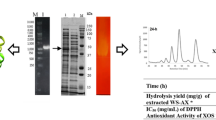Abstract
The rumen bacteriumPseudobutyrivibrio xylanivorans Mz5T has a potent xylanolytic enzyme system. A small native peptide (≈30-kDa, designated Xyn11A) from the bacterium was first isolated and characterized by Edman degradation. The gene coding for Xyn11A was identified using PCR amplification with consensus primers. It was then fully sequenced to reveal an open reading frame of 1809 bp. The predicted N-terminal domain exhibited xylanolytic activity and was classed to the family 11 of glycosyl hydrolases; it is followed by a region with homology to a family 6 cellulose binding module. The C-terminal domain codes for a putative NodB-like polysaccharide deacetylase which is predicted to be an acetyl esterase implicated in debranching activity in the xylan backbone. As similar domain organization was also found in several other xylanases from a diverse range of bacteria, a common ancestor of such a xylanase is considered to be present and spread, possibly by horizontal gene transfer, to other microorganisms from different ecological niches.
Similar content being viewed by others
References
Aurilia V., Martin J.C., McCrae S.I., Scott K.P., Rincon M.T. Flint H.J.: Three multidomain esterases from the cellulolytic rumen anaerobeRuminococcus flavefaciens 17 that carry divergent dockerin sequences.Microbiology 146, 1391–1397 (2000).
Béguin P.: Detection of cellulase activity in polyacrylamide gels using Congo-red-stained agar replicas.Anal.Biochem. 131, 333–336 (1983).
Biely P.: Microbial xylanolytic systems.Trends Biotechnol. 3, 286–290 (1985).
Biely P., Vršanská M., Tenkanen M., Kluepfel D.: Endo-β-1,4-xylanase families: differences in catalytic properties.J.Biotechnol. 57, 151–166 (1997).
Black G.W., Rixon J.E., Clarke J.H., Hazlewood G.P., Ferreira L.M.A., Bolam D.N., Gilbert H.J.: Cellulase binding domains and linker sequences potentiate the activity of hemicellulases against complex substrates.J.Biotechnol. 57, 59–69 (1997).
Čepeljnik T., Marinšek-Logar R.: Do rumen butyrivibria really possess only family 10 xylanases?Reproduct.Nutr.Develop. 44 (Suppl. 1), S57 (2004).
Čepeljnik T., Križaj I., Marinšek-Logar R.: Isolation and characterization of thePseudobutyrivibrio xylanivorans Mz5T xylanase XynT — the first family 11 endoxylanase from rumenButyrivibrio-related bacteria.Enz.Microb.Technol. 34, 219–227 (2004).
Chovanec P., Novák K.: Visualization of nodulation gene activity on the early stages ofRhizobium leguminosarum bv.viciae symbiosis.Folia Microbiol. 50, 323–332 (2005).
Dalrymple B.P., Swadling Y., Layton I., Gobius K.S., Xue G.-P.: Distribution and evolution of the xylanase genesxynA andxynB and their homologues in strains ofButyrivibrio fibrisolvens.Appl.Environ.Microbiol. 65, 3660–3667 (1999).
Davies G., Henrissat B.: Structures and mechanisms of glycosyl hydrolases.Structure 3, 853–859 (1995).
Fernandes A.C., Fontes C.M.G.A., Gilbert H.J., Hazlewood G.P., Fernandes T.H., Ferreira L.M.A.: Homologous xylanases fromClostridium thermocellum: evidence for bi-functional activity, synergism between xylanase catalytic modules and the presence of xylan-binding domains in enzyme complexes.Biochem.J. 342, 105–110 (1999).
Fialho M.B., Carmona E.C.: Purification and characterization of xylanases fromAspergillus giganteus.Folia Microbiol. 49, 13–18 (2004).
Gobius K.S., Xue G.-P., Aylward J.H., Dalrymple B.P., Swaldnig Y.J., McSweeney C.S., Krause D.O.: Transformation and expression of an anaerobic xylanase in several strains of the rumen bacteriumButyrivibrio fibrisolvens.J.Appl.Microbiol. 93, 122–133 (2002).
Hayashi H., Takehara M., Hattori T., Kimura T., Karita S., Sakka K., Ohmiya K.: Nucleotide sequences of two contiguous and highly homologous xylanase genesxynA andxynB and characterization of XynA fromClostridium thermocellum.Appl. Microbiol.Biotechnol. 51, 348–357 (1999).
Henrissat B., Teeri T.T., Warren R.A.J.: A scheme for designating enzymes that hydrolyze the polysaccharides in the cell walls of plants.FEBS Lett. 425, 352–354 (1998).
John M., Rohrig H., Schmidt J., Wienke U., Schell J.:Rhizobium NodB protein involved in nodulation signal synthesis is a chitooligosaccharides deacetylase.Proc.Nat.Acad.Sci.USA 90, 625–629 (1993).
Kirby J., Martin J.C., Daniel A.S., Flint H.J.: Dockerin like sequences in cellulases and xylanases from the rumen cellulolytic bacteriumRuminococcus flavefaciens.FEMS Microbiol.Lett. 149, 213–219 (1997).
Kopečny J., Marinšek-Logar R., Zorec M., Mrázek J., Kobayashi Y.:Butyrivibrio hungatei sp.nov., andPseudobutyrivibrio xylanovorans sp.nov., butyrate producing bacteria from the rumen.Internat.J.Syst.Evol.Microbiol. 53, 201–209 (2003).
Laemmli U.K.: Cleavage of structural proteins during the assembly of the head of bacteriophage T4.Nature 227, 680–685 (1970).
Mangala S.L., Kittur F.S., Nishimoto M., Sakka K., Ohmiya K., Kitaoka M., Hayashi K.: Fusion of family VI cellulose binding domains toBacillus halodurans xylanase increases its catalytic activity and substrate-binding capacity to insoluble xylan.J.Mol.Catal.B Enzym. 21, 221–230 (2003).
Mannarelli B.M., Evans S., Lee D.: Cloning, sequencing, and expression of a xylanase gene from the anaerobic ruminal bacteriumButyrivibrio fibrisolvens.J.Bacteriol. 172, 4247–4254 (1990).
Sakka K., Kojima Y., Kondo T., Karita S., Ohmiya K., Shimada K.: Nucleotide sequence of theClostridium stercorarium xynA gene encoding xylanase A: identification of catalytic and cellulose binding domains.Biosci.Biotechnol.Biochem. 57, 273–277 (1993).
Sambrook J., Russel D.W.:Molecular Cloning: a Laboratory Manual, 3rd ed., pp. A8.9-A8.18. Cold Spring Harbor Laboratory Press, New York 2001.
Sapag A., Wouters J., Lambert C., de Ioannes P., Eyzaguirre J., Depiereux E.: The endoxylanases from family 11: computer analysis of protein sequences reveals important structural and phylogenetic relationship.J.Biotechnol. 95, 109–131 (2002).
Zorec M., Marinšek-Logar R., Čepeljnik T., Nekrep F.V.: The influence of substrate concentration and growth phase on expression ofButyrivibrio sp. Mz5 endoxylanases.Zb.BF Univ.Ljubljan Kmetijstvo Zootehnika 76, 199–206 (2000).
Zorec M., Čepeljnik T., Nekrep F.V., Marinšek-Logar R.: Multiple endoxylanases ofButyrivibrio sp.Folia Microbiol. 46, 94–96 (2001).
Author information
Authors and Affiliations
Corresponding author
Additional information
The first author was supported by aMarie Curie Fellowship Program andFEBS short-term fellowship program.
Rights and permissions
About this article
Cite this article
Čepeljnik, T., Rincón, M.T., Flint, H.J. et al. Xyn11A, a multidomain multicatalytic enzyme fromPseudobutyrivibrio xylanivorans Mz5T . Folia Microbiol 51, 263–267 (2006). https://doi.org/10.1007/BF02931809
Received:
Revised:
Issue Date:
DOI: https://doi.org/10.1007/BF02931809




